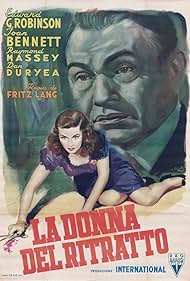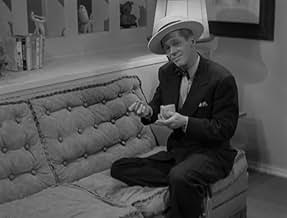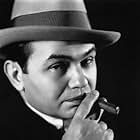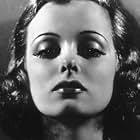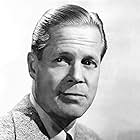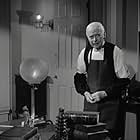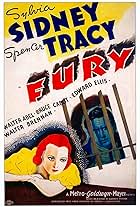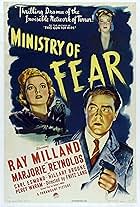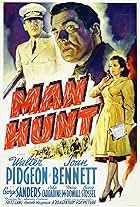Quando un professore di mezza età conservatore si cimenta in una piccola alleanza con una femme fatale, viene immerso in una sabbia da incubo di ricatti e omicidi.Quando un professore di mezza età conservatore si cimenta in una piccola alleanza con una femme fatale, viene immerso in una sabbia da incubo di ricatti e omicidi.Quando un professore di mezza età conservatore si cimenta in una piccola alleanza con una femme fatale, viene immerso in una sabbia da incubo di ricatti e omicidi.
- Candidato a 1 Oscar
- 3 candidature totali
- Dr. Michael Barkstane
- (as Edmond Breon)
- Streetwalker
- (non citato nei titoli originali)
- Club Member
- (non citato nei titoli originali)
- Man at Club
- (non citato nei titoli originali)
- Man in Taxi
- (non citato nei titoli originali)
- Club Member
- (non citato nei titoli originali)
- Dickie Wanley
- (non citato nei titoli originali)
- Man at Club
- (non citato nei titoli originali)
- Onlooker at Gallery
- (non citato nei titoli originali)
- Elsie Wanley
- (non citato nei titoli originali)
Trama
Lo sapevi?
- QuizThe painting of Alice Reed was done by Paul Clemens. He painted portraits of many Hollywood stars, often with their children. He was married to Eleanor Parker from 1954 to 1965.
- BlooperWhen Claude Mazard hits Alice in the face, his hand clearly does not actually hit her, yet she reacts to it.
- Citazioni
Alice Reed: Well, there are two general reactions. One is a kind of solemn stare for the painting.
Richard Wanley: And the other?
Alice Reed: The other is a long, low whistle.
Richard Wanley: What was mine?
Alice Reed: I'm not sure. But I suspect that in another moment or two you might have given a long, low, solemn whistle.
- Versioni alternativeAlso shown in a color-computerized version.
- ConnessioniFeatured in Ally McBeal: The Inmates (1998)
Richard Wanley (Edward G. Robinson) is a philosophy professor who discusses the nature of murder with his class the day his wife and children go off into the country for a vacation, leaving him alone in the city for a few weeks. He jokes with his friends at his club, the district attorney Frank Lalor (Raymond Massey) and Dr. Michael Barkstane (Edmund Breon), about how his newfound freedom saying that looking for adventure is the work of young men, not a man in his middle age. They talk about the unknown woman in a portrait in the window next to their club as the centerpiece of this discussion, and Wanley laughs it off. He's going to have another drink and go home to bed.
And yet, leaving the club, he meets the model of the portrait while admiring it. This is Alice Reed (Joan Bennett, sans awful cockney accent from Man Hunt), and Wanley is so tickled by meeting her that he agrees to an innocent drink with her. That drink in a public place becomes a trip up to her apartment to see the original sketches for the portrait, something that we believe Wanley is only there for. He's no lecher. He's being polite and interested in a young woman, is all. As he sits on her couch, waiting for her to bring in the sketches from the other room, a man bursts into the apartment and immediately attacks Wanley. Wanley defends himself while the man has his hands on Wanley's throat, and stabs him in the back with scissors that Alice hands him. He's killed someone. The academic talk about murder and the idle conversation of adventure have caught up with him.
No matter how innocent Wanley's intentions may have been, it all looks awful. The night his wife leaves town, he's in the apartment of an attractive young woman alone where he kills her lover. This is not something to take to the police, especially if he thinks he's smart enough to outwit them. It's interesting to watch what essentially amounts to a police procedural decades before CSI became a television mainstay. The little things that Wanley does wrong end up feeling like glaring mistakes, but forensics hadn't been popularized in any way, shape, or form by 1944, so Wanley not thinking of a tear of a fiber from his coat is understandable. What's a couple of fibers? It's not that important.
Except, of course, it is, and the middle bulk of the film is Wanley negotiating his status as the killer with his friendship of Lalor, the DA, and getting an inside scoop into the investigation, knowing how tightly the noose is getting around his neck with every passing moment. It's more sedate and methodically paced that something made today would be, but it's still effective in portraying the feeling of the walls closing in that never quite stops, especially when the added wrinkle of Heidt (Dan Duryea) appears.
The man Wanley killed was a powerful tycoon who kept his relationship with Alice secret, but his company was keeping tabs on Wanley through the bodyguard and tracker Heidt, an amoral hood who waits for the right moment after the crime to approach Alice and blackmail her. Wanley has to help, of course, and the two agree to murder Heidt to protect themselves. This movie is at its best here in the scenes between Alice and Heidt. The threat around Wanley is less immediate while the threat that Heidt represents Alice is more immediate, and Joan Bennett plays these scenes really well. She's terrified but hiding it under a cool, feminine exterior that's trying to exude confidence and calm while she knows that Heidt has everything on her and isn't the kind of guy to mess with.
The finale is a kind of mixture of coincidence that feels arbitrary and easy at first combined with tragic timing that makes up for it. And then, the film plays switcheroo on the whole movie, moving from a tragic ending to a comic one, and I lean towards it working. The dark of the proto-noir ending as bleakly as possible gives way to an amusing ending that pokes fun at itself, treating the film like a lesson to learn from for its main character instead of a firm final moment. It's like the ending of Fury, except it ends with a laugh instead of catharsis. In addition, like Fury, I don't think it undermines the overall point of the film, it just stands in such stark contrast to the rest of the film that it's somewhat shocking, especially on a first viewing (this is my second, the first was the horribly colorized version on Prime and I want to burn it with fire).
The methodical nature it deals with the police investigation may date the film, but it has the more immediate effect of proving to Wanley that he is running out of time and space to breathe, which is important. It's Joan Bennett that has the greatest emotional effect, though, her scenes with Dan Duryea being quietly intense as a lot goes on beneath the surface.
Lang manages it all well, especially in Alice's apartment. There's a lot of use of mirrors that allows for really interesting compositions, including two people looking directly at each other while allowing the camera to see both faces at the same time in the same shot. He was also working with a writer/producer individual (Nunnally Johnson) for the second time in a row, so it'd be interesting to see what the film would have become had Lang been given more freedom. It doesn't quite fit the rest of his work thematically, a similar distance created in Ministry of Fear, but he entertains well because he was a professional who understood the medium really well.
- davidmvining
- 8 set 2022
- Permalink
I più visti
Dettagli
- Data di uscita
- Paese di origine
- Siti ufficiali
- Lingua
- Celebre anche come
- The Woman in the Window
- Luoghi delle riprese
- New York, New York, Stati Uniti(background footage)
- Aziende produttrici
- Vedi altri crediti dell’azienda su IMDbPro
- Tempo di esecuzione1 ora 47 minuti
- Colore
- Proporzioni
- 1.37 : 1
Contribuisci a questa pagina

